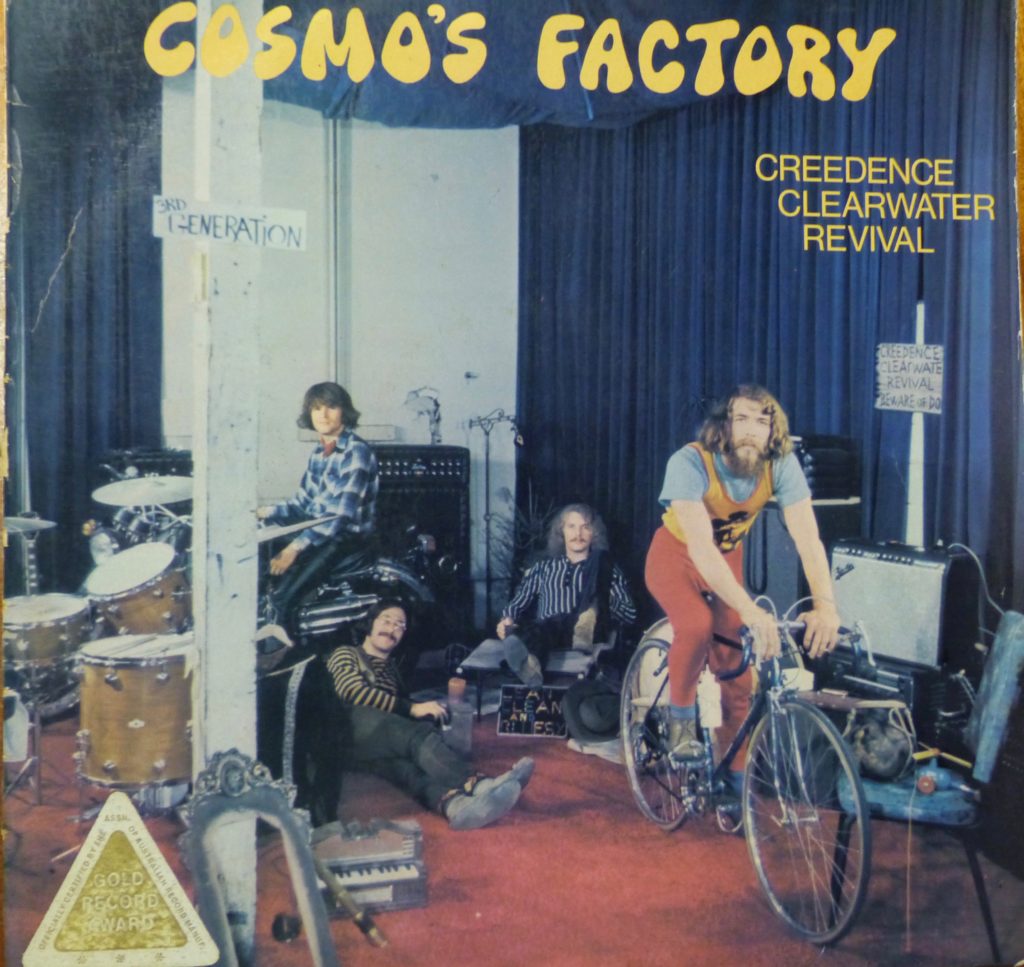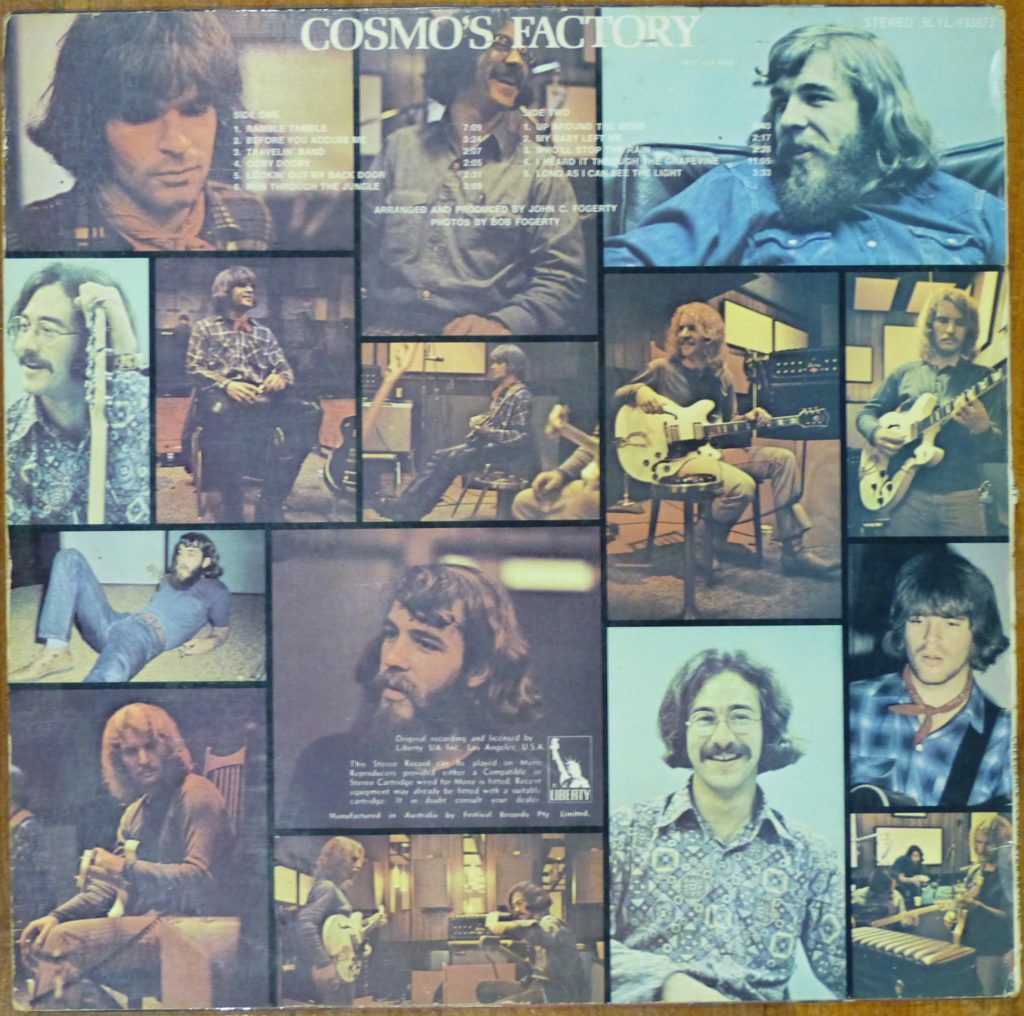Let me preface this new series on Sound Distractions with a little background. A week after my recent turntable purchase my brother Greg donated his vinyl collection to me after it had sat in a box without being played for many years. There was 1 album in particular in that box that held a significant place for me in my musical education – it was a no brainer as the most logical place to start my journey back into vinyl.
I grew up in a household filled with music. Mum and dad, along with my older brother and sister were all into music. It was the 1960’s and we had a healthy collection of records. Dad had some old 78’s (mostly country as far as I can recall), but it was the early rock n roll records that fired my senses. Most of it was courtesy of a stack of 45’s – the Beatles, Elvis, Roy Orbison and Buddy Holly amongst them but the first album that left an impression on me was Cosmo’s Factory. In 1970 my older brother Greg, who would have been 15 at the time brought it home and played it relentlessly. I was just 6 years old when that album was released yet I can still remember the day he brought it home and the impact it had on me. Greg was really excited about this band – I can’t recall if I was aware of them before then, but from that day on I became a fan.

The first thing that struck me about Cosmo’s Factory was the cover. Although the shot was obviously staged it had a casualness about it with the band lounging around their rehearsal room, dubbed “The Factory” by CCR’s drummer Doug “Cosmo” Clifford, who is sitting on his push bike while band leader John Fogerty straddles his motorbike. Bass guitarist Stu Cook stretches out on the floor apparently noodling on a toy piano as rhythm guitarist Tom Fogerty lounges on a chair with his feet perched on a sign that reads “lean, clean and bluesy”. There’s the obligatory drum kit and old school amps, yet strangely for a band with 3 guitarists there’s not a single axe in sight. Still it looks like a rehearsal room. In the bottom left corner resides a faded triangular sticker that was commonly seen on hit releases in Australia around that time – a “Gold Record Award. Officially certified by the Association of Australian Record Manufacturers”. I’m not entirely sure who they were, it sounds like it could be the guys at the pressing plant, but I suspect it was a mob with loftier intentions, if not ambitions.
So on to the record itself. Apart from a couple of early crackles it’s in surprisingly good nick given the repeated thrashings the album received at the time, particularly at a few raucous parties where my parent’s old stereogram (combined radio and turntable) was dragged out into the back yard. That in itself is a minor miracle.
Cosmo’s Factory opens with the magnificent Ramble Tamble, a song that was just made for listening to on the open road. This epic number is a journey within itself clocking in at over 7 minutes, which along with Hey Jude would have been the longest song I’d heard up to that point in my 6 year old life. The difference between those 2 songs though is that Ramble Tamble seems much longer because it changes tempo from a blistering opening guitar with a rockabilly beat into a drowsy psychedelic feel midstream that’s reminiscent of the Beatles’ I Want You, before returning to the rollicking guitar riff from the song’s opening. The song changes tempo like changing gears and is brilliantly held together by Cosmo’s drumming as he follows John Fogerty’s lead. It’s the kind of killer opening number every classic album needs.
On the album’s second track CCR instills the blues standard Before You Accuse Me with a little swamp boogie. It’s the blues yes, but unmistakably Creedence and sounding nice and muddy on that vinyl too. Travelin’ Band then kicks in with Fogerty in classic soul shouter mode. It’s his tribute to Little Richard and a convincing one too, so good that Mr Richard Penniman later filed a lawsuit against Fogerty for plagiarism (settled out of court). CCR jumps into the second cover of the album next and again they breathe new life into an old song and make it all their own. Listen to Roy Orbison’s version of Ooby Dooby from the mid 50’s and it sounds pedestrian up against this one.
Lookin’ Out My Back Door was the song from the album that I remember getting most of the radio airplay at the time. It’s an endearing shuffle that’s as catchy as all hell, though I still can’t understand half of what Fogerty is singing to this day – not that it matters with any good pop song. Side one finishes with the dark and atmospheric Run Through The Jungle. It’s a song that was closely associated with Vietnam at the time, though whether it was Fogerty’s intent I don’t know. It has a menacing feel complete with a honking harp – again it’s the blues Creedence style with a little swamp boogie in the mix. It’s a stunning track perfectly positioned as the closer for side 1 because it just makes you want to flip that disc over and get stuck into side 2. That’s one of the things I love about vinyl – the consideration of track placement and how those songs relate to the experience of listening to the record in their intended order. Something lost in the iTunes age.
Side 2 opens with the wailing guitar of Up Around the Bend, it’s essentially a feel good song – a call to get off your arse, play some music and socialize with your friends and if this record isn’t doing that for you already nothing will. My Baby Left Me is a straight out blues boogie. It may be a relatively simple song, but on vinyl it feels so much more alive (or is that ‘live’?) with the instrument separation. Who’ll Stop The Rain, one of Fogerty’s most loved songs is next. It’s beautiful melodic tone and acoustic arrangement makes it a stand out on the album, but it’s the song’s lyrical questioning of the status quo that still makes it relevant today. A timeless classic.
CCR’s epic take on Marvin Gaye’s I Heard It Through The Grapevine turns one of the greatest soul songs ever into an eleven minute masterpiece. It sounds like one long jam, but the looseness of the song’s feel could only have been achieved by a band that was as slick as a well-oiled machine. It’s an extraordinary piece of work. The closer for Cosmo’s Factory is Long As I Can See The Light. Sonically it comes as a relief after the thumping workout of Grapevine, yet it is perhaps the album’s most powerful moment. There is a feel to this song that I could never do justice to in words. The slow waltz is really just an accompaniment to Fogerty’s goose bump inducing vocal. This is the gospel according to J.C. Fogerty with an inspired sax solo (also played by Fogerty) and the only time this instrument was used in a Creedence recording. My lord what an impact it has on this song and what a finish for this astonishing album.

LOVE IT! Thanks for sharing. M.
Thanks Marty – such a fab album.
Hi Trev, Great memories of yesteryear, always a fan of Creedence Clearwater, I’m sure I wont be the only OLDIE to enjoy your revival of their music.
Cheers Margaret